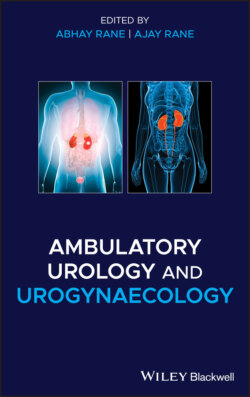Читать книгу Ambulatory Urology and Urogynaecology - Группа авторов - Страница 45
Fascial Support
ОглавлениеThe parietal and visceral (endopelvic) fascia constitute the fascial components. Parietal fascia covers the pelvic skeletal muscles and provides attachment of muscles to the bony pelvis extending from the lateral pelvic wall to the superior surface of pelvic diaphragm, and it is characterised histologically by regular arrangements of collagen. The obturator fascia covering the obturator muscle has two parts: ATLA and arcus tendineus fascia pelvis (ATFP), extending from IS to posterior pubis. Visceral endopelvic fascia is less discrete and not a true fascia but is endopelvic connective tissue. It contains a meshwork of loosely arranged collagen, elastin, and adipose tissue through which the blood vessels, lymphatics, and nerves travel to reach the pelvic organs. By surgical convention, condensations of this fascia have been described as discrete ‘ligaments’, such as the cardinal, uterosacral, pubovisceral, and pubourethral ligaments. The endopelvic tissue is a continuous layer extending from the uterosacral ligaments proximally to the pelvic portion of levator ani muscle distally, up to the level of urethra. The fascia also extends from the lateral wall of the cervix and vagina to the pelvic sidewall along the ATFP. This attachment stretches the vagina horizontally between the bladder and rectum thereby dividing the pelvis into an anterior and posterior compartment. The bladder and urethra occupy the anterior compartment; the rectum and anal canal, the posterior compartment; and the uterus and cervix, the middle or apical compartment.
Figure 2.3 Muscles of the deep perineal pouch.
DeLancey (1994) described the three integrated levels of pelvic support defined by the endopelvic connective tissue attachments to explain POP (see Table 2.1). All are connected through a continuation of the endopelvic fascia (Figure 2.4).
Table 2.1 Level of supports, with diagnosis and co‐relation to symptoms.
| Level of pelvic organ support | Organ affected | Type of Prolapse | Symptoms |
|---|---|---|---|
| Level I – uterosacral ligaments/ Cardinal ligaments | Uterus and cervix/vaginal vault | Uterocervical/ vault prolapse/ enterocele | Vaginal pressure, sacral backache, ‘something coming down’, dyspareunia, vaginal discharge |
| Level II – arcus tendineus fascia pelvis (ATFP) | Anterior ‐ Urinary bladder Posterior – Rectum | Cystocele Rectocele | ‘Something coming down’, double voiding, occult stress incontinence, recurrent urinary tract infections ‘Something coming down’, difficult defecation, manual digitation |
| Level III – anterior (pubourethral ligaments) | Urethra | Urethrocele | ‘Something coming down’, stress incontinence |
| Level III – posterior (perineal body) | Lower third of the vagina/ vaginal introitus/anal canal | Enlarged genital hiatus | Vaginal laxity, sexual dysfunction, vaginal flatus, needing to apply pressure to the perineum to evacuate faeces |
Figure 2.4 The endopelvic fascia in a post‐hysterectomy patient divided into DeLancey's biomechanical levels: level I, proximal suspension; level II, lateral attachment; level III, distal fusion.
